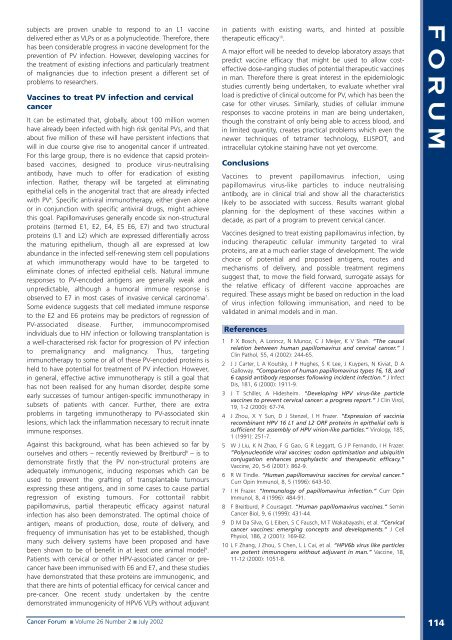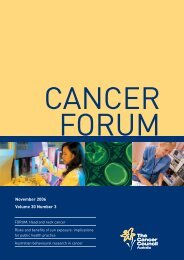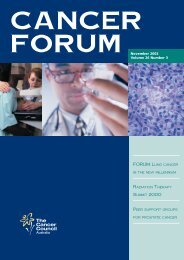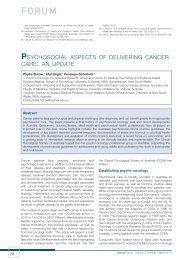Cancer Forum
Cancer Forum
Cancer Forum
- No tags were found...
Create successful ePaper yourself
Turn your PDF publications into a flip-book with our unique Google optimized e-Paper software.
subjects are proven unable to respond to an L1 vaccinedelivered either as VLPs or as a polynucleotide. Therefore, therehas been considerable progress in vaccine development for theprevention of PV infection. However, developing vaccines forthe treatment of existing infections and particularly treatmentof malignancies due to infection present a different set ofproblems to researchers.Vaccines to treat PV infection and cervicalcancerIt can be estimated that, globally, about 100 million womenhave already been infected with high risk genital PVs, and thatabout five million of these will have persistent infections thatwill in due course give rise to anogenital cancer if untreated.For this large group, there is no evidence that capsid proteinbasedvaccines, designed to produce virus-neutralisingantibody, have much to offer for eradication of existinginfection. Rather, therapy will be targeted at eliminatingepithelial cells in the anogenital tract that are already infectedwith PV 6 . Specific antiviral immunotherapy, either given aloneor in conjunction with specific antiviral drugs, might achievethis goal. Papillomaviruses generally encode six non-structuralproteins (termed E1, E2, E4, E5 E6, E7) and two structuralproteins (L1 and L2) which are expressed differentially acrossthe maturing epithelium, though all are expressed at lowabundance in the infected self-renewing stem cell populationsat which immunotherapy would have to be targeted toeliminate clones of infected epithelial cells. Natural immuneresponses to PV-encoded antigens are generally weak andunpredictable, although a humoral immune response isobserved to E7 in most cases of invasive cervical carcinoma 7 .Some evidence suggests that cell mediated immune responseto the E2 and E6 proteins may be predictors of regression ofPV-associated disease. Further, immunocompromisedindividuals due to HIV infection or following transplantation isa well-characterised risk factor for progression of PV infectionto premalignancy and malignancy. Thus, targetingimmunotherapy to some or all of these PV-encoded proteins isheld to have potential for treatment of PV infection. However,in general, effective active immunotherapy is still a goal thathas not been realised for any human disorder, despite someearly successes of tumour antigen-specific immunotherapy insubsets of patients with cancer. Further, there are extraproblems in targeting immunotherapy to PV-associated skinlesions, which lack the inflammation necessary to recruit innateimmune responses.Against this background, what has been achieved so far byourselves and others – recently reviewed by Breitburd 8 – is todemonstrate firstly that the PV non-structural proteins areadequately immunogenic, inducing responses which can beused to prevent the grafting of transplantable tumoursexpressing these antigens, and in some cases to cause partialregression of existing tumours. For cottontail rabbitpapillomavirus, partial therapeutic efficacy against naturalinfection has also been demonstrated. The optimal choice ofantigen, means of production, dose, route of delivery, andfrequency of immunisation has yet to be established, thoughmany such delivery systems have been proposed and havebeen shown to be of benefit in at least one animal model 9 .Patients with cervical or other HPV-associated cancer or precancerhave been immunised with E6 and E7, and these studieshave demonstrated that these proteins are immunogenic, andthat there are hints of potential efficacy for cervical cancer andpre-cancer. One recent study undertaken by the centredemonstrated immunogenicity of HPV6 VLPs without adjuvantin patients with existing warts, and hinted at possibletherapeutic efficacy 10 .A major effort will be needed to develop laboratory assays thatpredict vaccine efficacy that might be used to allow costeffectivedose-ranging studies of potential therapeutic vaccinesin man. Therefore there is great interest in the epidemiologicstudies currently being undertaken, to evaluate whether viralload is predictive of clinical outcome for PV, which has been thecase for other viruses. Similarly, studies of cellular immuneresponses to vaccine proteins in man are being undertaken,though the constraint of only being able to access blood, andin limited quantity, creates practical problems which even thenewer techniques of tetramer technology, ELISPOT, andintracellular cytokine staining have not yet overcome.ConclusionsVaccines to prevent papillomavirus infection, usingpapillomavirus virus-like particles to induce neutralisingantibody, are in clinical trial and show all the characteristicslikely to be associated with success. Results warrant globalplanning for the deployment of these vaccines within adecade, as part of a program to prevent cervical cancer.Vaccines designed to treat existing papillomavirus infection, byinducing therapeutic cellular immunity targeted to viralproteins, are at a much earlier stage of development. The widechoice of potential and proposed antigens, routes andmechanisms of delivery, and possible treatment regimenssuggest that, to move the field forward, surrogate assays forthe relative efficacy of different vaccine approaches arerequired. These assays might be based on reduction in the loadof virus infection following immunisation, and need to bevalidated in animal models and in man.References1 F X Bosch, A Lorincz, N Munoz, C J Meijer, K V Shah. “The causalrelation between human papillomavirus and cervical cancer.” JClin Pathol, 55, 4 (2002): 244-65.2 J J Carter, L A Koutsky, J P Hughes, S K Lee, J Kuypers, N Kiviat, D AGalloway. “Comparison of human papillomavirus types 16, 18, and6 capsid antibody responses following incident infection.” J InfectDis, 181, 6 (2000): 1911-9.3 J T Schiller, A Hidesheim. “Developing HPV virus-like particlevaccines to prevent cervical cancer: a progress report.” J Clin Virol,19, 1-2 (2000): 67-74.4 J Zhou, X Y Sun, D J Stenzel, I H Frazer. “Expression of vacciniarecombinant HPV 16 L1 and L2 ORF proteins in epithelial cells issufficient for assembly of HPV virion-like particles.” Virology, 185,1 (1991): 251-7.5 W J Liu, K N Zhao, F G Gao, G R Leggatt, G J P Fernando, I H Frazer.“Polynucleotide viral vaccines: codon optimisation and ubiquitinconjugation enhances prophylactic and therapeutic efficacy.”Vaccine, 20, 5-6 (2001): 862-9.6 R W Tindle. “Human papillomavirus vaccines for cervical cancer.”Curr Opin Immunol, 8, 5 (1996): 643-50.7 I H Frazer. “Immunology of papillomavirus infection.” Curr OpinImmunol, 8, 4 (1996): 484-91.8 F Breitburd, P Coursaget. “Human papillomavirus vaccines.” Semin<strong>Cancer</strong> Biol, 9, 6 (1999): 431-44.9 D M Da Silva, G L Eiben, S C Fausch, M T Wakabayashi, et al. “Cervicalcancer vaccines: emerging concepts and developments.” J CellPhysiol, 186, 2 (2001): 169-82.10 L F Zhang, J Zhou, S Chen, L L Cai, et al. “HPV6b virus like particlesare potent immunogens without adjuvant in man.” Vaccine, 18,11-12 (2000): 1051-8.<strong>Forum</strong><strong>Cancer</strong> <strong>Forum</strong> ■ Volume 26 Number 2 ■ July 2002114









